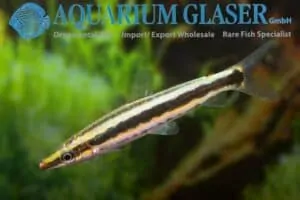Pygopristis denticulata – Lobetoothed Piranha
Pygopristis denticulata was described by Cuvier in 1844. Their common name is Lobetoothed Piranha.
Description
The Lobetoothed Piranha has a laterally compressed, silver-coloured body. The body of adults is similar in shape to that of the Red Piranha (Pygocentrus nattereri), but the Denticulata has larger fins. A pattern of dark stripes or dots is often visible on the flanks: as the fish gets older and darker, this becomes less visible. The back of these animals is often a bit bluish-grey, while the lower body, abdomen and gill covers have a more yellowish to reddish color. The fins are yellow to orange in color with a greyish onset. The tips of the fins, especially the caudal fin, are darker in color: orange-red to deep red. The adipose fin is quite large compared to that of other Piranha species.
Juveniles are silver in color with a fairly clear pattern on the flanks and a light coloration of the fins. The general appearance of juveniles is reminiscent of a silver dollar or young Pacu, but they have a more developed lower jaw than these species.

This Piranha has a unique tooth structure, which makes it quite easy to distinguish this species from other Piranha’s: the teeth are cone-shaped, with two much smaller teeth on either side of the “main tooth” (see illustration).
Distinctive / unique appearances
• Clear eyes.
• Strongly compressed body.
• Unique shape of the teeth.
• Yellowish to red fins.
• Convex, Pygocentrus-like head shape.
Maximum size
Pygopristis denticulata does not exceed 20 centimeters, although in captivity they rarely exceed 15 centimeters, making it one of the smaller piranha species.
Compatible Species
Pygopristis denticulata is blessed with a rather mild character by Piranha standards, but nevertheless remains a parasitic fin and scale eater and an opportunistic predatory fish. For that reason, it is best kept in a species aquarium. In a sufficiently spacious aquarium, this species can be kept in a small group, but this remains a risky affair.
When there are enough hiding places in the aquarium, a catfish such as a Pleco or a Thorny Catfish can be placed to take care of any food debris. However, there is no guarantee that this will go well. Other fish are unsuitable for keeping with this species.
Origin
South America: rivers in the basin of the Rio Orinoco in the north and east of British Guiana, tributaries in the middle and lower reaches of the Amazon in Brazil, British and French Guiana, Suriname and Venezuela.
This species has some color differences depending on its origin. The fish from Venezuela have a red / orange on the anal and caudal fins, and those from Brazil have a yellow color:


Diet
Fish (fillet, frozen whole fish such as smelt, live fish *), shrimp, mussels, insects, earthworms, bloodworms, mealworms, mosquito larvae, tubifex, flakes, tablet food, seeds, nuts, fruits.
* When feeding live fish, a number of things should be considered: First, all fish can introduce diseases and/or parasites into the aquarium, including goldfish, windes, and other commonly used cold water fish as well as tropical fish. It is therefore also advisable to first keep feed fish in a quarantine aquarium for a week or 2, in order to “flush” out the sick and weakened specimens. In addition, it should be taken into account that goldfish and close relatives are not particularly nutritious. A diet that usually consists of live fish is therefore not recommended. All the more because goldfish and other Cyprinidae (carp-like) contain hormones – so-called “Thiaminase / Vitamin B1 inhibitors” – that paralyze the production of certain growth-stimulating substances in predatory fish. A very one-sided goldfish diet can therefore lead to growth and development disorders!
It may take a while for the fish to accept prepared food: if this is the case, make sure the fish is well-fed with live food, then allow a fast of one week to 12 days. During this period, feed the desired prepared food with the lighting dimmed or switched off. If it doesn’t work the first time, supplement with live food and try again. Piranhas can go without food for a few weeks without any problems, so the fish is not at risk during this “cure” (except for specimens smaller than 8 centimeters!).
The Aquarium
At least an aquarium of 100x40x40 centimeters for adult specimens. Young fish can be temporarily kept in a smaller aquarium, with a minimum size of 60x30x30 centimeters. Given the temperament of this species, a group of these animals can be kept in an aquarium of at least 120x50cm.
The aquarium should be equipped with sufficient hiding places, obtainable by the use of (drift) wood, stones, and/or plants. This is to meet the often somewhat skittish nature of this fish. In addition, there should be sufficient open swimming space available, as this species is a fast swimmer. Optionally, a flow pump can be used for additional flow in the water.
Video
Author
Jonas Hansel – Piranha-info.com
Copyright images

Carl H. Eigenmann
KoS – CC BY-SA 3.0
AquariumGlaser.de








Reviews
There are no reviews yet.